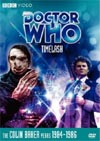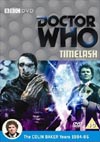DVD Extras include:
The sequence in which Vena steals the amulet and gets bumped down the time corridor is a prime example. Director Pennant Roberts attempts to record the whole thing "live" with a multi-camera set-up, forcing the actors to use unbelievably bad timing to hit their marks. Single camera work, akin to what we got during Peter Davison's action sequence in the warehouse during part four of "Resurrection of the Daleks" (story no. 134) the previous year, is what is called for. It's well within the technical capabilities for this period. Additionally, so much of the plot hinges on what happens here, there's little chance that it's a scene you could cut for time and/or lameness. So many other scenes could have simply done with extra takes, to nail the acting. A great disappointment.
Bent Out of ShapeBut as always, the script is where it all starts, and Timelash is replete with dialogue that doesn't really inspire great acting in the first place. Both Glen McCoy's scripts and Eric Saward's rewrites feature heavy doses of the type of irritating nagging that leads to the usual passive-aggressive violence for relief. Another mistake is in the realizing of "Herbert" as a kind of over-eager fan-boy, which never leads to a single scene that makes his character either good or wanted. Add to that the fact that they keep his main reason for being in the story a secret until the last scene, and one guarantees that he is not going to go over well with the audience in the meantime. The best the writers can hope for is last-minute forgiveness.And of course add to these problems all the usual story structure miscalculations needlessly adopted as status quo during this season of experimenting with 45-minute episode lengths. I will continue to automatically refer to the 25-minute international versions of this season's episodes, especially since it really highlights those miscalculations in the writing. The half-hour part one sees the guest cast on planet Karfel establish themselves and their conflicts fairly well - but all without any involvement from the Doctor and Peri, who spend the entire episode arguing and whining in the TARDIS. Why can't Saward see the advantage of bringing his main character to the scene of the story on time when commissioning storylines? It's baffling. The international Part One ends just after the TARDIS has landed, as Peri follows the Doctor out of the console room, responding to one of his admonishments with a sarcastic, "Yes sir!" Not a great cliffhanger. The international part two seems to be grasping at straws to find something to give the Doctor to do. Apart from being an overcomplicated way to get "Herbert" to the scene, the whole story beat of retrieving the amulet really has nothing to do with the rest of the story and is a huge distraction. Normally, the extra TARDIS movement and additional settings would be something I enjoy, but this portion of the story is realised a bit too cheaply for my tastes. Additionally, this retrieval sequence becomes the first of two major elements that deplete the whole idea that being thrown into the timelash is something to be feared. Once we've seen Vena thrown in, land safe and sound in Herbert's cottage, and get rescued by the Doctor, it doesn't seem so bad. Thus the threat of it doesn't make a great enough cliffhanger to part two for producer John Nathan-Turner to insist that the whole mis-timed story be bent out of shape to preserve it. The timelash suffers again in part three as we see Herbert and Mykros casually climb in and out of it as they please. It now becomes impossible to watch the story again and still take the threat of it seriously at all. At least the Doctor made it look like remaining tied to the Karfel end with a rope was necessary to avoid being thrown out the 1179 A.D. end of it. All things considered, the tunnel interior sequence needed more work making real the supposed pull towards the far end of it. Perhaps, yes build a vertical set, but shoot it with angles that make it look horizontal, and get the actors to move in sync with that idea.
It finally gets good....All things considered, the main conflict finally gels in part three and works better here than elsewhere. In fact, the sequences of the Doctor and the rebels defending the timelash/council chamber against invading guards and android, complete with the Doctor inventively using the resources at hand to come up with some surprise tactics, may well be the best plotted action sequences in the entire season, and with plenty of eye-candy effects, they do turn out fairly well. The acting still deserves to go up another notch, but isn't too bad here.In sharp contrast to my long-standing memory of the tale, Tekker and the Borad are actually still alive as part three draws to a close. The Borad finally reveals himself to the Doctor under threat in the villain's lair, while Mykros fails to convince the Bandrils out of their attack, and finally Peri is tied up in a cave facing a nasty Morlox as we cut to the credits. A triple-threat cliffhanger, coming about by accident! I must say, part three was slightly impressive.
Premature FinishI knew it wouldn't last though. Part Four climaxes early, as Tekker finally makes sense just before he exits the story, while the Doctor's cleverness finishes off the Borad in a satisfying blend of tactics and interesting sci-fi video effects. This is a great end to what the rest of the story had so carefully and successfully set up storywise. Although make-up and costume for the Borad isn't particularly inspiring, he has been quite effective in his lair through his various half-hidden, nicely voiced presences. This conclusion is still on the violent side, despite what Colin's dialogue tries to say. The Doctor has a good ten seconds to redirect the beam or decide not to, thus he MUST take his due responsibility for his adversary's demise.Now that we're past the conclusion of the story, at only 6 minutes into part four, we still have.... another 17 minutes to go! What the hell!? Key point: No way should the Doctor and Herbert have gone straight from the good sequences in the council chamber battles straight and unhindered into the Borad's lair. This is where additional story beats should have gone to occupy the Doctor prior to the story's final confrontation. Instead, this got messed up from the story-planning phase, long before the post-production rewrites and re-shoots began. The material with the Bandril missile is a good idea, but should be tightened up. It does drag on, and the ambassador isn't half as interesting as script descriptions suggested he should be. But we are getting a visibly alien culture on screen, which is decent. Perhaps more of these beats should come before the final confrontation, but if you still want to resolve them after the Borad's defeat, study "The Armageddon Factor" (story no. 103) as an example of how to tidy these things up with a good pace. Eric Saward's hastily added TARDIS interior scenes channel pure irritability onto the screen. It's utter crap, vastly out of place. Far better would have been technical jargon working on the problem of the missiles. Ultimately, the story really fails when trying to bring the Borad back again, post-death, as a clone. This totally springs out of nowhere, and goes nowhere, serving only to deflate the importance of the prior climactic confrontation that had worked so well. I suppose cloning partially excuses the ridiculousness of suggesting that Peri and the Borad could repopulate the planet by themselves, but it still isn't worth it. Timelash should have ended much, MUCH sooner, while it was still briefly on top of its game.
Salvaging Some CharismaFor all the numerous ideas experimented with in this adventure, the key quality to focus on that will determine success or failure is.... charisma. We need it in the dialogue, as Robert Holmes was good at doing. We need to go back for additional takes if it's missing from acting or action. We need it to permeate design of sets, costume, make-up, the works. Sadly, it seems the video effects might be the only department to have kept up to standard here.Dean Hollingsworth's android is a great example of good opportunity that needs more work. The make-up and artificial arm are suitably weird, and Hollingsworth produces some interesting mechanical movements to help sell his manufactured nature that are at times successfully disturbing. It does begin to resemble Michael Jackson's famous "moonwalk" a bit too much at times though. The voice tonality though.... big mistake! Predictably alternating syllables between three pitches, all of which are too high, lacks CHARISMA. We need dispassionate menace. Watch Arnold Schwarzenegger in "Terminator", and learn. In fact, just listen to Laurence Payne's computer voice on the space station from "The Two Doctors" (the previous story), and you'll hear something that could have kept the android's presence much more dangerous. Ah well. It's curious that the android(s) make no appearance whatsoever during our anti-climactic part four, another indication of extremely poor plot planning by the writers. We do get to see a few good performances here. Colin Baker is quite good on the whole in this story. In fact, even in scenes where other actors appear lost opposite him, Colin's presence seems to be salvaging the charisma somewhat and bringing the scene back up to a half decent level. A truly valiant effort. Other kudos go to the actors playing Maylin Renis, Aram, Sezon, and Katz, who manage some really sympathetic performances. I was especially pleased to see Denis Carey produce a flawless and compelling performance in one of the most undervalued roles of the story. Carey combines really well with Robert Ashby's excellent vocal work to build up a superb sense of mystery and anticipation surrounding the Borad's history and true nature. Nicely done. A lot of the other actors with major roles are doing their best, but Pennant Roberts' directing is really letting them down this time. I really wasn't impressed by Paul Darrow's Tekker when I first saw the story, but then after having seen how well he did as a leading regular on Blake's 7, I find it easier to be sympathetic with what he is attempting here. I think he gets much better as the story progresses. Indeed, it's probably not until his last scene that his character makes sense on paper, and this is, I think, where Darrow is at his best. As another nod to Blake's 7, that show's sound effects designer from the BBC Radiophonic Workshop, Liz Parker, actually gets to compose the incidental music here. Although it may not be the greatest of the Workshop's electronic scores, it serves the story well. Perhaps it does suffer slightly from the intellectual urge to find originality by breaking all the rules and playing notes seemingly at random, which often seemed to define mainstream experimental electronic music early on. But, we will find themes, motifs, and defining instrument sounds here, and there is much artistic merit in the score. The most defining, memorable portions for me are the disjointed bits augmenting the movements of the android. Nice.
International Titles:Deutsch: "Das Amulett"Magyar: "Időostor"Français: (Lanière temporelle)Русский: "Удар времени"This story has become available on DVD and VHS video. Click on the Amazon symbol for the location nearest you for pricing and availability:
Comments on this article are welcome. You may contact the author from this page:
|








